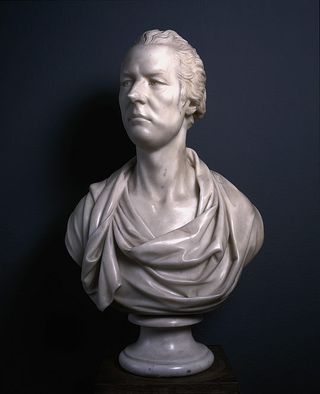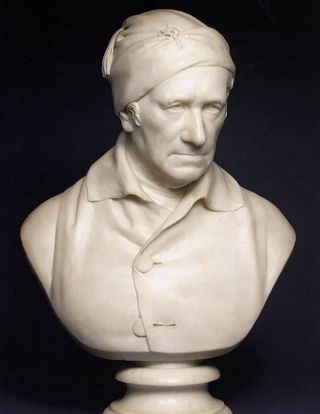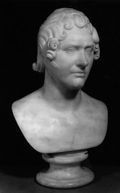When did the toga go out of fashion?

I'm hard at work on my "Twelve Caesars" lectures in Washington. And I'm thinking about the question of how, why and when modern, living people were represented, in portraits statues, wearing Roman dress -- like Pitt the Younger by Nollekens, above.
There have been flurries of interest in particular aspects of this question (in, for example, the tirade of Joshua Reynolds against Benjamin West, for doing his painting of the Death of Wolfe, below, in modern, rather  than Roman, kit). But my question is a bigger one. When, in the mainstream tradition of Anglo-American portrait sculpture does it become simply unthinkable to put your sitter in a toga or Roman armour? It was an option often taken, though never exclusive, from the beginning of the modern tradition of portraiture, in the fifteenth century century on. When did it start to seem silly? (We cant, after all imagine David Cameron, JFK or even Churchill being sculpted 'all'antica".)
than Roman, kit). But my question is a bigger one. When, in the mainstream tradition of Anglo-American portrait sculpture does it become simply unthinkable to put your sitter in a toga or Roman armour? It was an option often taken, though never exclusive, from the beginning of the modern tradition of portraiture, in the fifteenth century century on. When did it start to seem silly? (We cant, after all imagine David Cameron, JFK or even Churchill being sculpted 'all'antica".)
And a related, but significantly different question, is: which is the latest mainstream portrait we can find, in which the sitter is portrayed in Roman costume?

Of course, the boundaries can be a bit blurred. It's easy enough to recognise an uncompromisingly contemporary portrait bust, like Chantrey's bust of John Tooke above (roughly contemporary with Nollekens's Pitt). But there are all kinds of shades in between.
 You can fudge the cultural specificity by giving the bust no clothes at all, like Bartolini's portrait of Lord Byron on the left. Or you can choose clothes that somehow come in between the Roman and the modern (academic or clerical dress are both usefully interstitial in this respect).
You can fudge the cultural specificity by giving the bust no clothes at all, like Bartolini's portrait of Lord Byron on the left. Or you can choose clothes that somehow come in between the Roman and the modern (academic or clerical dress are both usefully interstitial in this respect).
But when did this become simply off limits?
Mussolini may be an exception, but so far as I can see the tradition of Roman portrait costume had pretty much gone on both sides of the Atlantic by the First World War.
Can anyone push it further than that?
Mary Beard's Blog
- Mary Beard's profile
- 4110 followers



